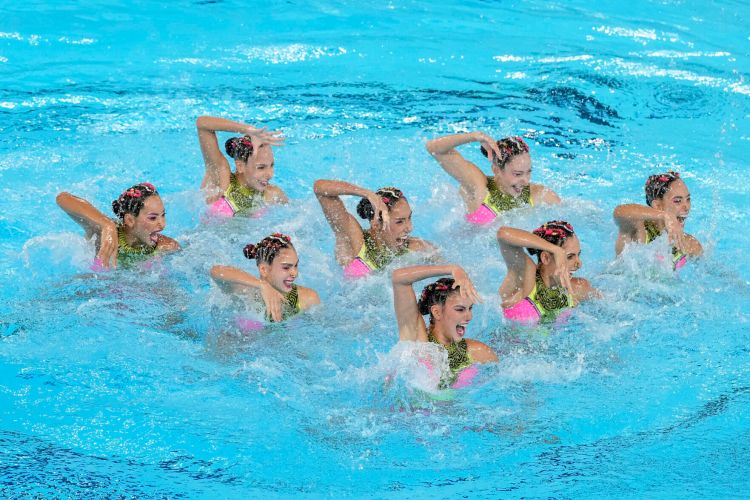Paris olympics artistic swimming – As the Paris Olympics draw near, artistic swimming takes center stage, promising a spectacle of athleticism, artistry, and grace. From its captivating origins to its cutting-edge techniques, the sport has evolved into a mesmerizing display of human potential.
The evolution of artistic swimming techniques has been a journey of innovation, with swimmers pushing the boundaries of physical expression. From synchronized movements to daring acrobatics, the sport demands both athleticism and artistic flair.
History of Artistic Swimming at the Paris Olympics
Artistic swimming, formerly known as synchronized swimming, has been a captivating spectacle at the Paris Olympics since its debut in 1900. The sport’s origins can be traced back to the late 19th century, when water ballets were performed by female swimmers as a form of entertainment.
In 1900, the first Olympic swimming competition included a category for “fancy swimming,” which allowed swimmers to showcase their artistic skills and creativity. This event marked the unofficial beginnings of artistic swimming as an Olympic sport.
Significant Milestones

- 1952 Helsinki Olympics:Artistic swimming was officially recognized as a separate sport and included in the Olympic program.
- 1984 Los Angeles Olympics:Duet and team events were added to the artistic swimming competition.
- 1996 Atlanta Olympics:Artistic swimming made its debut as a medal event for women.
Evolution of Artistic Swimming Techniques

Over the years, artistic swimming techniques have undergone significant advancements, transforming the sport from its humble beginnings to the highly technical and graceful discipline it is today.
Technical Innovations

- Underwater propulsion:Swimmers now use underwater propulsion techniques to create lift and move through the water with greater efficiency and speed.
- Inverted figures:Artistic swimmers have developed intricate inverted figures, where they perform upside-down movements and poses, demonstrating exceptional balance and coordination.
- Synchronized lifts:Synchronized lifts require precise timing and strength, as swimmers lift and support their partners above the water’s surface, creating visually stunning formations.
Choreography and Synchronization, Paris olympics artistic swimming
Choreography and synchronization play a crucial role in artistic swimming. Swimmers must execute complex routines that are perfectly timed and synchronized with music, creating a harmonious and visually appealing performance.
Notable Athletes and Teams: Paris Olympics Artistic Swimming
Artistic swimming has produced numerous iconic athletes and teams who have captivated audiences with their exceptional skills and achievements.
Legendary Swimmers
- Esther Williams:Known as the “American Mermaid,” Williams was a Hollywood star and Olympic swimmer who popularized artistic swimming in the 1940s and 1950s.
- Tracie Ruiz-Conforto:A three-time Olympic medalist, Ruiz-Conforto is renowned for her technical prowess and graceful performances.
- Natalia Ishchenko:A Russian swimmer, Ishchenko has won 20 Olympic and World Championship medals, making her one of the most decorated artistic swimmers in history.
Exceptional Teams
- United States:The U.S. team has dominated artistic swimming at the Olympics, winning numerous medals and consistently showcasing technical excellence and innovative choreography.
- Russia:Russia has also been a powerhouse in artistic swimming, producing some of the sport’s most talented and successful athletes.
- Japan:The Japanese team is known for its intricate and synchronized routines, which often incorporate traditional Japanese elements.
Final Thoughts
Artistic swimming at the Paris Olympics is not just a competition but a celebration of human creativity and athleticism. The athletes’ dedication, skill, and artistry come together to create a breathtaking spectacle that leaves a lasting impression on all who witness it.
Detailed FAQs
What are the origins of artistic swimming at the Paris Olympics?
Artistic swimming, then known as synchronized swimming, made its Olympic debut at the 1984 Paris Olympics.
What are the key elements evaluated in artistic swimming performances?
Judges assess technical merit, artistic impression, and execution, including elements such as synchronization, difficulty, and choreography.
Who are some of the most iconic artistic swimmers in Olympic history?
Notable athletes include Virginie Dedieu, Natalia Ishchenko, and Svetlana Romashina, who have won multiple Olympic medals.